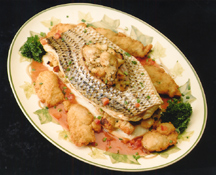|
Dock of the Bay Rallying the Troops In Annapolis, Clark supporters thinking vice president Even before retired Gen. Wesley Clark’s Oklahoma victory during February 3rd’s seven-state primary, his supporters had come to terms with reality.
“I am not disengaged; I’ve always followed politics,” said Stoehr. “But this was the first time I’ve found a candidate who makes me passionate.” Still, Clark’s Annapolis supporters were ready to rally behind whatever man Democrats eventually field against President George W. Bush. That sentiment was not strictly partisan. “I had never not voted in an election,” said 75-year-old Judy Housley of Bay Ridge, a registered Republican. “But I couldn’t bring myself to vote for Bush or Gore in 2000.” In November, she promised, “I’ll vote for a man who owns his own uniform and doesn’t show up in a borrowed flight suit.” That qualification would narrow her choice to Clark or Massachusetts Sen. John Kerry, himself a Vietnam veteran. Don’t dare, Housley says, call her unpatriotic for disapproving of the president and his policies. “If we put a bad guy into the White House, it is our patriotic duty to get him out.” In Gen. Clark’s Maryland army, Housley has done more than talk. The retired grandmother of eight joined two busloads of Marylanders who headed north to New Hampshire and went door to door for her candidate. Thirty-nine-year-old Charlie Rewa of Crownsville was also steeled to switch his allegiance to a new commander in chief. With Sen. John Kerry continuing as front runner, “Maybe,” said an undaunted Rewa, “we can get Gen. Clark on Kerry’s ticket,” meaning as the senator’s vice-presidential running mate. But with the Democrat’s nominee yet to be decided, the bumper stickers, pins and yard signs Rewa handed out still put Clark’s name first. “One thing is sure,” he smiled. “We aren’t going to quit fighting.” — Louis Llovio
Man’s Best Friend Moves Up in the Family Colonial Players’ Sylvia imitates life Pets have a hold on our hearts. The neighborhood children love them, and some adults are so enamored they have chosen to forego the kids and adopt an animal instead.
The problem arises because dogs, he explained, do not see their families as people but instead as fellow dogs who are part of their pack. He recommends training to establish the human’s position in the home as the Alpha or Top Dog. Dogs are not alone in seeing their housemates as family. Humans, too, are extending their definition of family to include the animals in their homes. “There has been a dramatic change in how people relate to their animals,” said PETsMART’s Andrea Davis, describing the shift away from animals as work partners. As baby boomers seek to fill their empty nests and young adults postpone childbearing, a new breed of parents has arisen: pet parents. “People have come to think of their pets as children,” said Davis, a 20-something pet parent hoping to delay traditional motherhood. “She’s my baby,” she said of her dog. Davis is not alone in this belief. “I’m the grandfather of a dog,” said Dave Barnes of his granddog Sunny. Barnes and his wife Mary, both of Annapolis, say they are frequent babysitters, with the dog being asked by his parents, much as a child would be, “Do you want grandpa to watch you tonight?” Director James understands. “They’re my kids,” she said of her two dogs, Señor Henry and Miss Jingles. “Everybody thinks I love my dogs more than anybody else.” Animals, she said, are worth the conflicts they cause in the play and in real life. “They give unconditional love and they never talk back,” she said. — Naomi Smoot-Kimble Earth Journal ~ Brown Creeper The woods are quiet except for the sound of leaves underfoot. Even in their leafless state, the bare trees muffle traffic sounds. A flock of geese breaks the silence before fading off toward the river. The place is so still that it seems to be asleep.
Adaptations that evolved out of different approaches to foraging for food account for the physical differences. The chickadees, titmice and kinglets are generalist; they eat a little of this and a little of that: fruit, seeds, buds, insects. As they have no need for specially adapted beaks or feet, their appearance is generic. The woodpecker, nuthatch and creeper are specialists. Their food-finding methods include pounding, tapping or probing for insects. These birds have highly specialized body parts: strong skulls and beaks, purposeful feet and tail feathers. The brown creeper is a short, slender bird with a downward curved bill and cryptically patterned brown and tan plumage. The long, curved bill is good for probing under bark for insects and spiders. Like the woodpeckers, the creeper has very stiff tail feathers. Instead of perching on branches, woodpeckers and creepers usually hang on the trunks and large branches. This is where their specially adapted tails come in. The stiff tail feathers act as props that helps them stay upright as they grip the trunks of trees. True to their name, brown creepers creep. In their search for food, they creep up, never down. They are only capable of perching vertically and moving in one direction: up. Up, up and up. Eventually they reach a point where they don’t want to go up anymore. Being birds, they then fly. So when they reach a certain point on the tree, they swoop down, like a falling leaf, to the base of another tree and start over. With the Watermen’s Expo, Can Spring Be Far Behind? The singular success story of Chesapeake Bay is the recovery of the rockfish, as the striped-bass gamefish is known locally. When rockfish populations collapsed in the 1980s, prompting a five-year fishery moratorium, Maryland rockfish anglers and seafood lovers of the flaky white meat fish tightened their belts and looked to the future.
But if the trip down makes you hungry, join professional and amateur chefs at the rockfish cook-off. Ten finalists were chosen by a committee of judges that includes watermen, says Noreen Eberly of Maryland Department of Agriculture’s Seafood and Aquaculture Marketing. Contestants hail from Annapolis, Baltimore, Columbia, Havre de Grace and, on the Eastern Shore, Ocean City, Tylerton and Galena. Each has an hour to prepare two one-pound fillets, with demonstrations every 10 minutes. “Rockfish are plentiful, and the winter rockfish is known for its quality and taste,” says Eberly. Whet your appetite on 2003’s first-place winner, Rich Hoffman’s Seared Rockfish Fillet with Oyster and Corn Stew. Hoffman is chef at Rudy’s 2900 in Finksburg. Or third-place winner Andy Weber’s Maryland Rockfish with Roasted Yellow Pepper Grits and Poblano Sauce. Weber dreams up his recipes in his Edgewater kitchen. Or Marty Hyson’s Lemon Herb-Crusted Rockfish on Home-Style Garlic Mashed Potatoes. Hyson — a mortgage banker in Baltimore and past grand-prize winner in the National Oyster Cook-off in St. Mary’s County — calls Maryland seafood-cooking competitions his “hobby.” Hyson got honorable mention in the 2003 rockfish cook-off after placing second in 2002 with his Rockfish Braised in Apple Juice on Baby Wilted Spinach with Pine Nuts. “Every year, my recipes seem to grab the judges attention,” says Hyson, who’s hoping his luck will hold this year, when he’s cooking Pan-Braised Rockfish with Champagne Butter Sauce. Hyson and four other contestants are amateurs; the other five cook for a living. Eberly says she’ll balance the competition this year by awarding two first prizes of $500 plus a second-place prize, $350, and third place at $200. To taste for yourself, see 8 Days a Week. — M.L. Faunce Haiti Visits Maryland Hall In Matenwa, Haiti, art has become sustenance. Out of a rocky, arid, barren land where little thrives, now come silky, bright, color-rich scarves. The silk scarves produced by the women of Matenwa have brought hope and business to their small village. In Annapolis, Marylanders cheered last week when EPA administrator Mike Leavitt arrived to announce a $10 million grant for sewage treatment in Bay country. But the Bush Iraq-war budget this week showed overall cuts of $50 million in programs that help the Bay, the Baltimore Sun tabulated… In Lothian, Maryland’s Board of Public Works has approved spending $1.25 million in Project Open Space funds to purchase and preserve the Riggleman farm, a mile of waterfront along the Patuxent River near Jug Bay… In Norway, the scourge of the 20th century’s most evil man continues. Nearly 60 years after the defeat of Adolf Hitler, Nazi chemical weapons are oozing from their rusting containers at the bottom of European seas, sometimes harming fishermen who bring them up in their nets, Reuters reports… In Germany, the beer barons are shaking their heads at a disturbing trend: For the fourth straight year and the eighth year in ten, beer-loving Germans consumed less brew. Why? A population growing older and, the barons say, a pro-environment 25-cent deposit on bottles and cans… Our Creature Feature comes from Washington, D.C., where the Agriculture Department is taking the guts out of a polka tune by saying don’t eat the guts out of cows. |
© COPYRIGHT 2004 by New Bay Enterprises, Inc. All rights reserved.
Last updated February 5, 2004 @ 12:05am.





 These silk squares and rectangles are not native products of Haiti, the poorest country in the Western Hemisphere. Social injustice — a history of slavery, dictatorship and civil strife leading to crushing poverty — has robbed the Caribbean island of its natural resources. Villagers struggle to provide for their families. Survival takes all the land has to offer. Trees chopped down for firewood and charcoal have exposed the once-fertile soil, which erosion routinely washes away.
These silk squares and rectangles are not native products of Haiti, the poorest country in the Western Hemisphere. Social injustice — a history of slavery, dictatorship and civil strife leading to crushing poverty — has robbed the Caribbean island of its natural resources. Villagers struggle to provide for their families. Survival takes all the land has to offer. Trees chopped down for firewood and charcoal have exposed the once-fertile soil, which erosion routinely washes away.